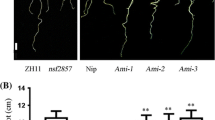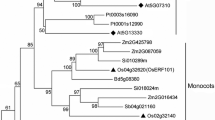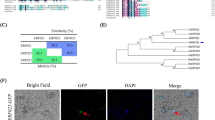Abstract
ERFs, the largest group of AP2/EREBP transcription factors, are involved in diverse processes in plants. However, their importance in growth and development is not fully understood. Here, we report OsRAF (a Root Abundant Factor gene in Oryza sativa), a new member of the rice ERF group, expressed more abundantly in roots than in other organs of rice at the transcriptional level. Moreover, the expression could be up-regulated by ethylene or low temperature. Transient expression of OsRAF::GFP fusion in onion epidermis cells and its overexpression in Arabidopsis revealed that OsRAF was a nucleus localized protein. Down-regulation of OsRAF’s expression by RNAi method failed to produce aberrance in transgenic rice, which suggests existence of functionally redundant gene(s).




Similar content being viewed by others
References
Banno H, Ikeda Y, Niu QW et al (2001) Overexpression of Arabidopsis ESR1 induces initiation of shoot regeneration. Plant Cell 13:2609–2618
Chuck G, Muszynski M, Kellogg E et al (2002) The control of spikelet meristem identity by the branched silkless1 gene in maize. Science 298:1238–1241
Decker CJ, Parker R (1995) Diversity of cytoplasmic functions for the 3′ untranslated region of eukaryotic transcripts. Curr Opin Cell Biol 7:386–392
Ding ZJ, Wu XH, Wang T (2002) The rice tapetum-specific gene RA39 encodes a type I ribosome-inactivating protein. Sex Plant Reprod 15:205–212
Elliott RC, Betzner AS, Huttner E et al (1996) AINTEGUMENTA, an APETALA2-like gene of Arabidopsis with pleiotropic roles in ovule development and floral organ growth. Plant Cell 8:155–168
Fujimoto SY, Ohta M, Usui A et al (2000) Arabidopsis ethylene-responsive element binding factors act as transcriptional activators or repressors of GCC box-mediated gene expression. Plant Cell 12:393–404
Gu YQ, Yang C, Thara VK et al (2000) Pti4 is induced by ethylene and salicylic acid, and its product is phosphorylated by the Pto kinase. Plant Cell 12:771–786
Gutterson N, Reuber TL (2004) Regulation of disease resistance pathways by AP2/ERF transcription factors. Curr Opin Plant Biol 7:465–471
Jung J, Won SY, Suh SC et al (2007) The barley ERF-type transcription factor HvRAF confers enhanced pathogen resistance and salt tolerance in Arabidopsis. Planta 225:575–588
Jofuku KD, den Boer BG, Van Montagu M et al (1994) Control of Arabidopsis flower and seed development by the homeotic gene APETALA2. Plant Cell 6:1211–1225
Kumar S, Tamura K, Nei M (2004) MEGA3: integrated software for molecular evolutionary genetics analysis and sequence alignment. Brief Bioinform 5:150–163
Magnani E, Sjolander K, Hake S (2004) From endonucleases to transcription factors: evolution of the AP2 DNA binding domain in plants. Plant Cell 16:2265–2277
Maes T, Van de Steene N, Zethof J et al (2001) Petunia Ap2-like genes and their role in flower and seed development. Plant Cell 13:229–244
Mitchell PJ, Tjian R (1989) Transcriptional regulation in mammalian cells by sequence-specific DNA-binding proteins. Science 245:371–378
Moose SP, Sisco PH (1996) Glossy15, an APETALA2-like gene from maize that regulates leaf epidermal cell identity. Genes Dev 10:3018–3027
Nakano T, Suzuki K, Fujimura T et al (2006) Genome-wide analysis of the ERF gene family in Arabidopsis and rice. Plant Physiol 140:411–432
Ohme-Takagi M, Shinshi H (1995) Ethylene-inducible DNA binding proteins that interact with an ethylene-responsive element. Plant Cell 7:173–182
Okamuro JK, Caster B, Villarroel R et al (1997) The AP2 domain of APETALA2 defines a large new family of DNA binding proteins in Arabidopsis. Proc Natl Acad Sci 94:7076–7081
Russell JE, Liebhaber SA (1996) The stability of human beta-globin mRNA is dependent on structural determinants positioned within its 3′ untranslated region. Blood 87:5314–5323
Sakuma Y, Liu Q, Dubouzet JG et al (2002) DNA-binding specificity of the ERF/AP2 domain of Arabidopsis DREBs, transcription factors involved in dehydration- and cold-inducible gene expression. Biochem Biophys Res Commun 290:998–1009
Sessa G, Meller Y, Fluhr R (1995) A GCC element and a G-box motif participate in ethylene-induced expression of the PRB-1b gene. Plant Mol Biol 28:145–153
Van der Graaff E, Dulk-Ras AD, Hooykaas PJ et al (2000) Activation tagging of the LEAFY PETIOLE gene affects leaf petiole development in Arabidopsis thaliana. Development 127:4971–4980
Weigel D (1995) The APETALA2 domain is related to a novel type of DNA binding domain. Plant Cell 7:388–389
Yang Y, Li R, Qi M (2000) In vivo analysis of plant promoters and transcription factors by agroinfiltration of tobacco leaves. Plant J 22:543–551
Zhang J (2003) Overexpression analysis of plant transcription factors. Curr Opin Plant Biol 6:430–440
Zhang L, Tao J, Wang S et al (2006) The rice OsRad21–4, an orthologue of yeast Rec8 protein, is required for efficient meiosis. Plant Mol Biol 60:533–554
Zhou J, Tang X, Martin GB (1997) The Pto kinase conferring resistance to tomato bacterial speck disease interacts with proteins that bind a cis-element of pathogenesis-related genes. EMBO J 16:3207–3218
Acknowledgement
The research was supported by grants from the National Science Foundation of China (No.30370138 and No.30570147).
Author information
Authors and Affiliations
Corresponding author
Rights and permissions
About this article
Cite this article
Hu, Y., Chong, K. & Wang, T. OsRAF is an ethylene responsive and root abundant factor gene of rice. Plant Growth Regul 54, 55–61 (2008). https://doi.org/10.1007/s10725-007-9228-5
Received:
Accepted:
Published:
Issue Date:
DOI: https://doi.org/10.1007/s10725-007-9228-5




